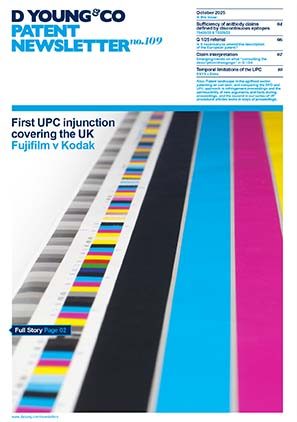Inventive step at the Unified Patent Court: 12-months in, what do we know so far?
For an invention to qualify for patent protection it must have an inventive step; however, the manner in which inventive step is assessed may vary by jurisdiction. With the UPC in its infancy, patent attorneys have been eagerly awaiting guidance from the UPC Court of Appeal on substantive matters of patent law, such as inventive step.
In this article, we look at the UPC’s approach to inventive step, with reference to the Court of Appeal’s decision in Nanostring Technologies Inc v 10x Genomics Inc (UPC_CoA_335/2023).
In this decision the Court of Appeal overturned a first instance ruling for a preliminary injunction against Nanostring Technologies, finding the patent asserted by 10x Genomics to be “more likely than not” invalid.
This was the first decision by the Court of Appeal that included a detailed assessment of infringement and validity.
UPC Court of First Instance
10x Genomics alleged infringement of European unitary patent EP4108782 by Nanostring Technologies’ “CosMx” products, and applied for a preliminary injunction against Nanostring Technologies in Europe. The patent claims concern a method of detecting a plurality of analytes in a cell or tissue sample. The UPC Court of First Instance found “with sufficient certainty” that the patent was valid and infringed, and ordered that a preliminary injunction be issued.
A key point under inventive step was whether it would have been obvious to apply the in vitro method of a prior art document, Göransson, to an in situ method involving cell or tissue samples (as specified in the patent claims).
Without referencing it explicitly, the Court of First Instance’s assessment of inventive step used many of the cues of the problem-solution approach, which is how inventive step is assessed at the European Patent Office (EPO). It involves:
- determining the closest prior art;
- assessing the technical effect achieved by the claimed invention when compared with the closest prior art;
- defining the objective technical problem to be solved, the object of the invention being to achieve said effect; and
- considering whether or not the claimed solution, starting from the closest prior art and the objective technical problem, would have been obvious to the skilled person.
An important element of the problem-solution approach is the determination of the closest prior art, and on this the Court of First Instance commented:
“The (closest) prior art to be used for determining lack of inventive step is usually a prior art document disclosing an object developed for the same purpose or with the same aim as the claimed invention and having the most important technical features in common with it, i.e. requiring the fewest structural changes. An important criterion in choosing the most promising starting point is the similarity of the technical task.
The skilled person would not have used Göransson as a realistic starting point, let alone as the closest prior art, in view of the task according to the patent. Göransson is not aimed at detecting a large number of analytes in a cell or tissue sample […]. Rather, the object of consideration in Göransson is ASMs [amplified single molecules] on “a new random array format”.
Göransson does disclose a similar “encoding and decoding method” to that used in the patent at issue, but in a very different context, namely ASMs on an array”.
Ultimately, the Court of First Instance was “not convinced” that the patent “will be declared invalid for lack of inventive step”.
UPC Court of Appeal
The Court of Appeal disagreed with the Court of First Instance’s assessment of inventive step, and particularly the suitability of Göransson as the closest prior art:
“[Göransson] D6 would have been of interest to a person skilled in the art who, at the priority date of the patent at issue, was seeking to develop high-throughput optical multiplexing methods for detecting target molecules in a sample, as it discloses a method for detecting a plurality of amplified single molecules (ASMs) by encoding and decoding the single molecules, wherein the encoding is performed via probe-mediated generation of ring-shaped DNA and the decoding is performed by temporally sequential detection of the targeted ASMs.
This is admittedly disclosed in D6 for ASMs ordered in vitro in an array format. However, given the demand for multiplex analysis techniques, especially for test samples, at the priority date […], there was a need to consider whether the encoding and decoding method disclosed in D6 could be transferred to the detection of ASMs in cell or tissue samples”.
The Court of Appeal considered that “after successful application of an in vitro multiplex method for the detection of ASMs the next step was to consider transferring the method to an in situ environment”.
The Court of Appeal overturned the first instance decision, based on the finding that claim 1 of the patent “more likely than not” will prove to be obvious.
Assessment of inventive step
The manner in which inventive step is assessed can of course have a significant impact on the outcome of a case. For example, while the EPO problem-solution approach involves identifying the closest prior art, the approach before the German national courts typically does not. Instead, the German courts consider that the starting point for assessing inventive step can be any reference(s) a skilled person would find realistic ante inventionem (before discovery). One can envisage scenarios in which a prior art document considered too remote for selection as the closest prior art under the EPO problem-solution approach might be considered an acceptable starting point for the German courts.
In Nanostring Technologies v 10x Genomics, the Court of Appeal neither endorsed nor criticised the problem-solution approach, and did not state that it had used any particular methodology.
In effect, the Court of Appeal left open the possibility of assessing inventive step using the problem-solution approach or a national approach, or establishing its own approach.
Interestingly, the Court of Appeal did not refer to any case law (EPO or national) in relation to inventive step. Perhaps this was a deliberate attempt to avoid drawing attention to a specific approach at this early stage. Nevertheless, the Court of Appeal decision is somewhat consistent with a “broad” line of EPO case law, which is that “if the skilled person had a choice of several workable routes…the invention has to be assessed relative to all these possible routes”.
The most represented nationalities of UPC judges are German, French, Italian, Dutch, and Swedish. With this in mind, it can be reasonably expected that such national (and EPO) case law may significantly influence practice at the UPC.
France, Italy, and Sweden assess inventive step similarly to the EPO, using a problem-solution approach. The Netherlands also uses a similar approach, but does not exclude others. Germany approaches inventive step differently from the EPO. As discussed, a key difference is that while the EPO requires identification of the closest prior art Germany does not.
In Nanostring Technologies 10x Genomics the legally qualified Court of Appeal judges included Mr Klaus Grabinski (German), Ms Françoise Barutel (French), and Mr Peter Blok (Dutch), and the technically qualified judges included Mr Rainer Friedrich (German), and Mr Cornelis Schüller (Dutch). All had significant experience before the EPO and/or national courts, and the technically qualified judges had relevant technical expertise in biotechnology.
An evolving approach to inventive step
In view of the Court of Appeal’s non-committal approach to inventive step in Nanostring Technologies v 10x Genomics it is advisable to assess inventive step bearing in mind the problem-solution approach and the national approaches, at least until a set methodology is established. In practice this will involve developing full inventive step attacks or defences from any prior art document constituting a reasonable starting point.
It also must be remembered that in Nanostring Technologies v 10x Genomics the Court of Appeal was assessing validity in the context of whether to grant a preliminary injunction. Whether the Court of Appeal will take a more definitive approach in main proceedings on the merits remains to be seen. Many substantive decisions will be issued in 2024 and 2025 and are expected to provide guidance on this topic.
It is noteworthy that the patent under consideration in Nanostring Technologies v 10x Genomics is also subject to opposition before the EPO. Those EPO proceedings have been accelerated, and it will be interesting to see how the approach by the EPO opposition division compares to the different approaches of the UPC Court of First Instance and Court of Appeal.
Case details at a glance
Decision level: Court of Appeal, Luxembourg
Case: UPC_CoA_335/2023
Order/decision: ORD_595990/2023 (26 February 2024) & ORD_12169/2024
Parties: Nanostring Technologies (Inc, Germany GmbH & Netherlands BV) v President and Fellows of Harvard College, 10x Genomics Inc
Date: 11 March 2024
Decision: dycip.com/nanostring-10x-coa
Decision level: Munich Local Division
Case: UPC_CFI_2/2023
Order/decision: ACT_459746/2023
Parties: Nanostring Technologies (Inc, Germany GmbH & Netherlands BV) v 10x Genomics Inc, President and Fellows of Harvard College
Date: 19 September 2023
Decision: dycip.com/upc-nanostring-10x-cfi
Useful links
- WIPO: an international guide to patent case management for judges, chapter 5 Germany: dycip.com/patent-case-management-guide
- EPO: case law of the Boards of Appeal, tenth edition, I. Patentability, D. Inventive step, 3. Closest prior art, July 2022: dycip.com/caselaw-boa-inventivestep

